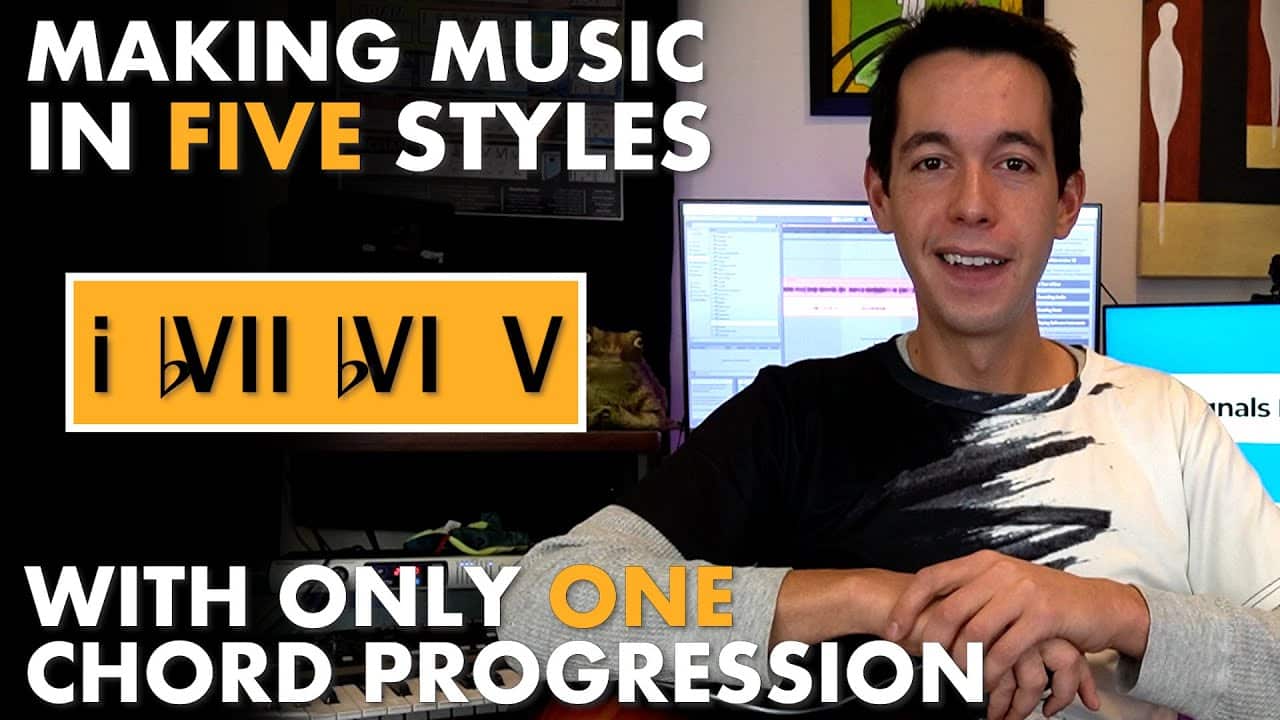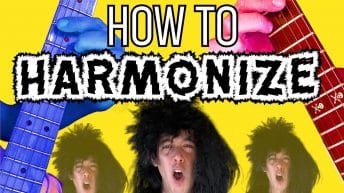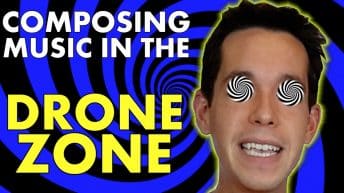Beginning composers often avoid common chord progressions, fearing they’ll sound generic. But a common chord progression is like a classic recipe – master it first, then add your own creative spin.
Today we’re exploring the Andalusian Cadence, demonstrating how one simple four-chord progression can become five completely different musical styles. This is one of the many chord progressions we explore in the Chord Progression Codex, a complete guide to mastering music theory and chord progressions.
What is the Andalusian Cadence?
The Andalusian Cadence follows this pattern: start on any minor chord, then jump back a whole step to a major chord, another whole step to a major chord, and finally a half step to a major chord. Here’s an example starting on Em:
Those first three chords are found naturally in the minor/aeolian scale, but that final B major chord contains D#. That’s the leading tone in E, and is not normally part of the E minor scale. However, it’s part of the E Harmonic minor scale, and we can easily shift to that scale over that chord to perfectly match its tension.
If you’re confused on that stuff, you should consider watching my three-part series on the Harmonic Minor Scale.
Where You’ve Heard It
There is no shortage of examples to choose from to experience this sound for yourself. A clear cut example can be found in the verses of “Runaway” by Del Shannon, and another can be found in “Stray Cat Strut” by the Stray Cats. You’ll also find it hidden away within the verses of “Sultans of Swing” by Dire Straits and “Walk Don’t Run” by the Ventures.
Writing With The Andalusian Cadence
This is a very versatile chord progression that is easy to write with. The video up top shows more examples in action but here’s a few to consider:
Style 1: Latin Jam
Let’s use this progression in its native genre: latin, or flamenco style. This time we’ll begin on Dm, which means our progression will look something like this.
We’ll add some ornamentation to those chords too. For example, Dm and C will both be seen alongside their sus4 counterparts, and Bb will sometimes have a #11 added to it. This isn’t too fancy – we’re simply adding notes from the Dm scale into our chords to add interest.
Style 2: Video Game Metal
Let’s switch to the key of A minor, where an Andalusian Cadence would look like this:
Now, instead of playing those chords as full chords, we’ll play them as powerchords to give it a heavier metal sound. We’ll include palm mutes, and syncopated changes, as well as a pedal point melody. The lead guitar uses the A minor scale over the first three chords, then switches to A Harmonic Minor over the E chord at the end.
We’ll also avoid just looping through the progression, and write a longer section where the full Andalusian Cadence only shows up for a bit. It looks like this:
After that progression wears out its welcome, you’ll hear a different progression all together (again in the key of A minor) and solo on top to demonstrate how well this progression works when paired side-by-side with something else.
Style 3: Psychedellia
We’ll start in A minor again: Am – G – F – E. However, for those first three chords, our bass won’t change. Instead, it’ll drone on as a pedal tone to create a floatier and less active low end. We’ll also change our orchestration to include some trippier-sounding instruments, like synths and pads.
And of course, no psychedellic track is complete with out the soothing sounds of Terence McKenna’s papal voice.
More Options
I’ve included three more examples of how to use this progression in the video up top. It’s a fun demonstration and I bet you’ll enjoy it. But overall, here’s the point: you probably won’t invent a new chord progression – with only 12 notes, most combinations have been explored. But originality comes from what you do with existing progressions.
The difference between generic and musical lies in your compositional toolkit: rhythm patterns, chord inversions, voicings, arpeggio techniques, and arrangement choices. These tools transform simple progressions into personal musical statements.
If you want to learn more on how to wield chords and scales, consider buying my Theory and Songwriting Course. It’ll teach you everything you need to know to start writing your own music while understanding the theory behind it, making it communicate your ideas to others and expand upon them.





